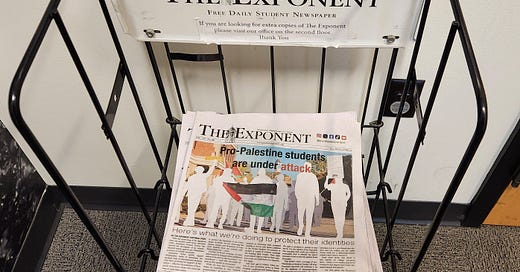Why Purdue’s student newspaper erased pro-Palestinian protesters’ names
Balancing credibility and harm: 'You have to ask yourself,' expert says
When the Trump administration moved to scrutinize pro-Palestinian student activists, student journalists at Purdue University erased something else: The digital traces that could put their classmates at risk.
“Pro-Palestinian students are under attack, so we're removing their names,” The Purdue Exponent’s editorial board declared.
The decision drew national attention, placing the newspaper at the center of a broader conversation about journalistic ethics, safety and press freedom. The editor received more than 7,000 emails, including death threats, in just 24 hours.
“It wasn’t a really long-out discussion; it kind of came up organically,” said Seth Nelson, editor-in-chief. “We have a responsibility to minimize harm. It’s one of the SPJ’s (Society of Professional Journalists) Code of Ethics, so it was an obvious choice at that point.”
The Exponent has since removed names, images and likenesses of every pro-Palestinian student published since Oct. 7, 2023, from its website.
It also pledged to omit such identifying details in future coverage until President Donald Trump’s executive order is overturned.
That order calls for colleges and universities to “monitor for and report” antisemitic activities by international students and staff, with Trump pledging visa revocation and deportation for “pro-jihadist” students and “Hamas sympathizers on college campuses.”
“When letters of visa revocation arrive in these students’ mailboxes and federal agents come to Purdue’s campus, no distinction will be made between ‘pro-jihadist’ and pro-Palestinian,” the editorial board stated. “Pro-ceasefire will continue to be conflated with ‘antisemitic.’ Anti-war can only now mean ‘pro-Hamas.’”
Calling the order a “blatant violation of the First Amendment rights of potentially hundreds of Purdue students,” the newspaper saw itself as an outlet that could take action by avoiding being associated with this.
A policy rooted in precedent
The decision wasn’t made in isolation.
Nelson said The Exponent had been receiving name removal requests since last year’s encampment and protests.
He explained the newspaper has long maintained a policy of removing names and images when a student’s safety is at risk, making this move consistent with its pre-existing standards.
Nelson emphasized the decision wasn’t about taking sides in the larger conflict but about “objectively standing” for the First Amendment.
“We’re not making a statement about the protest themselves, not making a statement about Palestine itself,” Nelson said. “All The Exponent is saying is we just don’t want to be part of this and we're not going to aid and abet this.”
Only eight editors signed the editorial, despite The Exponent’s website listing 13 editors. Nelson acknowledged the discomfort within the newsroom, noting some senior staff members — including noncitizens — didn’t want their names attached.
“But there was enough of the editorial staff that did, and that’s enough to say that The Exponent, as an organization, kind of agrees with this,” he said.
Even though Trump’s order targets international students, Nelson said the paper removed all names because it’s hard to know someone’s immigration status.
Nelson handled the removal process himself, staying up late to make the changes. He then asked readers to reach out if anything was missed.
Nelson believes other student newspapers should consider similar actions.
“If you are a student journalist in this country,” he said, “you have that obligation too.”
Ethical considerations
Covering protests requires journalists to balance transparency with potential harm.
At a recent New York University panel, journalism professors and students weighed the ethics of publishing protesters’ names and faces, balancing journalistic integrity, public interests and the risks to individuals.

Stephen Adler, director of NYU’s Ethics & Journalism Initiative, said ethical considerations go beyond legality — they require weighing the value of an action.
While including photos and names enhances credibility, Adler noted the negatives such as the increasing legal risks, particularly regarding immigration status.
“You have to ask yourself how do you balance those interests,” said Adler, former editor-in-chief of Reuters.
Adler said he personally leans toward an “old-school” approach — if a story is newsworthy and people are in a public space, he would show their faces.
“The story is yours, it’s not theirs,” he said, describing his mindset.
He acknowledged younger journalists tend to see things differently but urged them to consider whether their ethical choices would remain consistent across different scenarios.
“Would you not include the name of the neo-Nazi?” he asked. “Would you not include the name of a racist speaker?”
Journalists, he said, must ask themselves what they are trying to accomplish. While those who speak publicly assume some level of risk, there’s a difference between exposing someone to consequences and putting them in actual danger.
He noted that vulnerability should factor into the decision, particularly regarding immigration. Still, he cautioned against a blanket rule.
Sheila Coronel, director of Stabile Center for Investigative Journalism at Columbia University, said she would frame camera angles to avoid direct faces, but given today’s surveillance state, she questioned the effectiveness of such measures.
Yezen Saadah, editor-in-chief of Washington Square News, said student newspapers exist to serve their campus communities.
His newsroom typically includes names and faces, but with pro-Palestinian protesters, the risks felt “unprecedented.”
“There are instances where the content of the protest is more important than who it is, who is doing actual protesting,” Saadah said.
Ultimately, Saadah said his newsroom always returns to its core mission: “We are students. We are covering our campus. What’s going to be the most deterrent journalistically efficient way of doing so in a way that gets this point of what journalism is all about.”
“We are serving our community,” he added.
💬 I want to hear from you! What are some ethical choices you have had to make as a student journalist covering your campus? Email me at nutgrafnews@gmail.com.
Story Spotlight:
💸 The University of Kansas’ student government proposed cutting 80% of funding for the student newspaper The Daily Kansan for undisclosed reasons. A petition against the proposal has garnered more than 7,500 signatures.
🚩 The Post Athens at Ohio University said Meta briefly took down its Instagram page after flagging stories about Ohio legislation around diversity, equity and inclusion.
📱 From print to Reels: How student journalists at Boston-area colleges are crafting news for the digital age. Instead of strategizing ways to make young people read print, they tailored their reporting to a mobile-first audience.
😎 Gen Z teens told Fortune why they stopped trusting experts in favor of influencers on TikTok: “Influencers feel like friends … the more you see them the more you trust them.”
📰 Check out this powerful headline from The Daily Texan’s Feb. 11 issue’s front page:
Featured Opportunities:
Student Press Law Center is hosting a webinar on the state of college press freedom Feb. 18. Check out events for Student Press Freedom Day here.
The Next Generation Newsroom and the Pittsburgh Media Partnership are looking for summer interns. Apply before Feb. 24.
Applications for the McClatchy HBCU Development Internship Program are open until Feb. 28.
Wisconsin Public Radio is seeking a Lee Ester News Fellow. Apply before Feb. 28.
Applications for the Al Neuharth Free Spirit and Journalism Conference in Washington D.C. are open until March 23. Everything is covered for the 51 high school juniors selected.
GBH in Boston has multiple internship positions open for the summer.
NBC Connecticut is looking for summer interns across departments.
The National Press Club and the NPC Journalism Institute are accepting applications for all 2025 scholarships until March 16.








